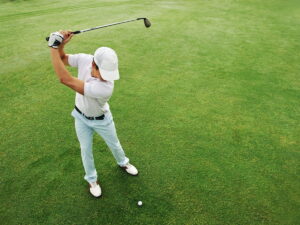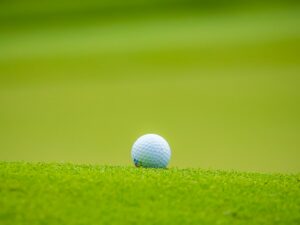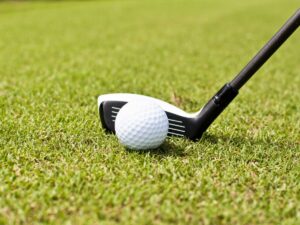
What’s Inside a Golf Ball? History & Evolution Explained
*This post may contain affiliate links. We are reader supported and earn affiliate commissions when you buy via links found on our site*

- Last Updated on
Contents
If you’re like a lot of golfers, chances are you’ve wondered, what’s inside a golf ball? It’s a good question as golf balls have evolved significantly in the past century.
In fact, I bet you didn’t know that golf balls once had feathers inside them? Or that adding dimples was somewhat accidental but a huge development in the game.
Needless to say, we’ve come a long way in the 2, 3, and 4-piece modern golf ball design. They make the game slightly easier thanks to more distance, more spin, and more consistency.
Today we’ll help you understand what’s inside each golf ball and how different types can help your game.
What’s Inside a Golf Ball?
It’s hard to believe how much golf equipment has evolved over the years.
Drivers and fairway woods used to be made of wood with screws in the middle of the face. While irons looked more like butter knives than the forgiving cavity back irons a lot of golfers use today.
Golf balls themselves have evolved significantly as well. Original golf balls were made of beech or box wood then leather balls filled with chicken or goose feathers and painted white. Then came the gutta percha ball, a wound golf ball, and now modern polyurethane covered balls.
Let’s just say that golf ball design has come a long way and no doubt made the game easier. Modern golf balls now have three main features; a core, mantle, and cover – which we’ll cover in more detail later.
What’s inside each golf ball depends on the type of ball as there are many options. If you want to actually see what’s inside a ball check out this popular YouTube video.
Now, let’s get into each type of ball to determine what’s really inside.
One-Piece Golf Balls
One piece golf balls are the most basic type of balls that are primarily used for driving ranges. They’re very cheap to produce but aren’t the best in terms of performance.
The 1 or 2-piece design is why you probably notice a big difference with distance and spin of a range ball vs. your normal ball. Most one piece golf balls are made of Surlyn plastic. The dimples are molded into it and get worn down due to the constant use on the driving range.
Two-Piece Golf Balls
A two-piece golf ball is another cheaper type of golf ball that is used on driving ranges and for beginner golfers. These golf balls have a large core that is solid rubber (they used to be made of liquid).
Then they have a thin rubber layer and are wrapped in plastic. You’ll notice a big difference between 1 and 2-piece golf balls as these will produce more spin. Two-piece balls have a very different compression than three or four piece balls.
These are great choices for casual golfers who don’t have a ton of swing speed. Plus, they’re a lot cheaper than a multi-layer golf ball.
Some examples of two-piece balls include:
- Bridgestone e6
- Titleist Tour Soft
- Callaway Supersoft
- TaylorMade Distance+
Three-Piece Golf Balls
A three-piece golf ball tends to have a similar rubber core as a two-piece golf ball. But the layer around the core – known as the mantle – is added for more performance benefits.
The most popular three-piece ball is the Titleist Pro V1. This ball has revolutionized the game and has become the number one ball in golf across all professional tours. They’re also a great choice for skilled amateurs as well.
Here are some of our favorite picks for three-piece golf balls:
- Kirkland
- Titleist AVX
- Srixon Z-Star
- Callaway Chrome Soft
- Bridgestone Tour B RXS
- TaylorMade Tour Response
Four-Piece Golf Balls
A four-piece golf ball has an extra layer that can change the spin and distance capabilities. Some examples include:
- Srixon Z-Star
- Titleist Pro V1X
- Wilson Staff Model
- Callaway Chrome Soft X
- Titleist Pro V1X Left Dash
Additionally, there are a few golf balls that are 5-piece or 6-piece as well. One of the best examples is the TaylorMade TP5 series which are quite comparable to the Titleist Pro V1X balls.
Due to the advanced design, 3-6 piece golf balls are the most expensive to manufacture. The typical cost for a dozen usually ranges from $40 to $55. But they’re often marked up significantly if you buy them in a pro shop so make sure to buy them online or at a golf store to save money.
Golf Ball Construction
As mentioned above, there are three facets of a golf ball – the core, mantle, and cover. Let’s review each to see how they affect overall performance and costs.
Golf Ball Core
The core is the innermost part of the ball that has evolved significantly over the years. Liquid cores started nearly 100 years ago but were eventually replaced by layers in the 1960s.
Now, golf balls have a solid rubber core that changes in terms of design for different types of golfers.
Golf Ball Mantle
Covering the core of the ball (in some designs) is the second layer known as the mantle. This part of the ball plays a pivotal role in controlling spin in conjunction with the core.
Golf Ball Cover
The final component of a golf ball is the cover itself which determines the durability. Golf balls are primarily made of Surlyn or urethane.
Surlyn is a type of inomer that is cheaper to manufacture and offers a more durable design. This type of cover is more common in driving range balls and ones that are made for beginners (such as 1-piece or 2-piece designs). These balls can withstand a lot more damage without damaging the cover but don’t provide as much feel.
Urethane is the cover on most premium golf balls such as the Titleist Pro V1. These covers are a type of ionomer and provide more feedback and feel for golfers.
Unfortunately, the feel and feedback don’t make them nearly as durable. This is why you’ll need to replace these types of balls more often as they’re prone to cuts and knicks.
Not to mention these covers are generally much more expensive as well. But if you’re a skilled golfer playing these types of balls can make a big difference in your game.
If you aren’t sure what type of golf ball to use, make sure to try out an online ball fitting tool. After answering a few questions you can easily figure out which is right for your individual swing.
Top Questions About Golf Balls
Keep reading if you want to learn more about golf ball design and figure out which ball is right for you.
What is the inside of a golf ball called?
The inside of a ball is known as the core. Cores can have 1–6 pieces depending on the make and model.
Outside the core is the mantle and then exterior which is known as the cover. Each ball has a different amount of dimples, core, mantle, and exterior to create its own characteristics.
Are there limits to the size of a golf ball?
Yes, according to the rules of golf (which is the R&A and USGA), a ball cannot be any smaller than 1.680 inches. While the weight cannot exceed 1.620 ounces and the ball must have a spherical shape. But they can be different colors such as yellow, red, green, and blue.
Are there rubber bands in golf balls?
No, there are no rubber bands in golf balls – anymore. Since the start of the 21st century golf balls have had a solid construction as it’s easiest for manufacturers to create these in bulk. Plus, the newer design leads to better performance and consistency on the golf course.
What chemicals are in golf balls?
The composition of a golf ball varies depending on the type of ball and manufacturer. For example, cheaper designs (like 1 and 2-piece range balls) are made primarily of rubber and plastic.
While 3 and 4-piece golf balls are more detailed. According to Biodegradable Golf Balls, “Some of the ingredients of a high-end modern golf ball are: thermoplastics, zinc oxide, zinc acrylate, benzoyl peroxidem heavy metals, polybutadiene, and other propriety blends of materials not disclosed by the manufacturer.”
How many golf balls are lost each year?
It’s been estimated that there are more than 300 million golf balls lost each year! While it’s tough to verify this statistic there’s no doubt that golfers lose plenty of golf balls in hazards, out of bounds, and other areas.
How many golf balls are lost per round?
Most golfers lose at least one golf ball per round. But it depends on the skill level, golfer, and type of course. For example, some courses have a lot more water hazards than others which can lead to losing 2, 3, or more balls each round.
While others might replace them more often if they get damaged from trees, cart paths, etc.
If you want to save money and not replace balls as often make sure to grab a ball retriever as well.
Related: Find the Straightest Golf Ball
What is the rarest golf ball in history?
The rarest golf ball in the game is known as the “Gutta Percha” also known as the “guttie.” This ball was used in the 1800s and at the time, revolutionized the game. It was one of the first mass-produced balls that was easily accessible to the public.
This type of golf ball used resin from a Sapodilla tree and was made spherical by heating and shaping it into a mold. They were cheap to produce and accidentally led to the design of dimples after discovering that the knicks actually created a more consistent ball flight.
Why are there dimples on a golf ball?
Dimples help a golf ball become more aerodynamic and improve performance. There are between 300 and 500 dimples on a golf ball but more doesn’t necessarily mean better.
Without dimples golf balls would suffer greatly in terms of distance, accuracy, and spin. In fact some studies have found that a ball would only go half as far if it didn’t have dimples!
What ball does Tiger Woods use?
Tiger Woods has used a variety of golf balls over his illustrious career. He formerly played Titleist golf balls, then Nike, and now Bridgestone.
Currently, Tiger plays the Tour B XS TW edition. This is the exact ball that Tiger himself plays in competition with the “TIGER” logo stamped on each one. This ball delivers explosive distance, more spin around the green, and a dual dimple pattern for a more consistent trajectory.
Wrapping Up
Golf balls continue to evolve every year thanks to endless R&D by big brands like Titleist, TaylorMade, Bridgestone, and others.
Whether you’re a scratch golfer, beginner, or someone who wants to break 80, you need to play the right ball. Otherwise, you might miss out on spin and distance to help you shoot lower scores.
Use an online ball fitting tool to see which make/model will work best for your game. Then, test them out on the golf course and in practice to see which one suits you best.
Do you play the same golf ball for 18 holes (if you don’t lose it) or replace it?
Let us know in the comments below.

Phil Grounds
Phil is an avid golfer, and the creator of The Golfers Gear. He’s been playing golf for 30 years, and is obsessed with improving his game and sharing his experience helping fellow golfers score better.





